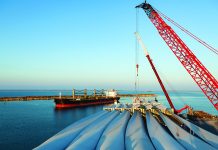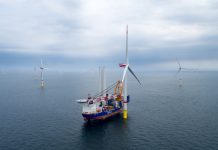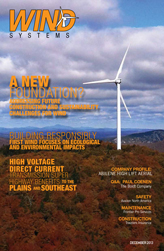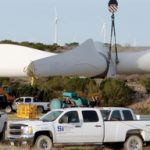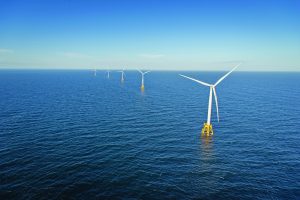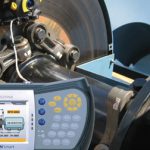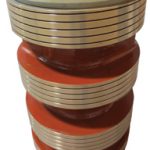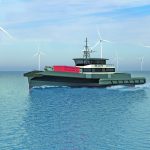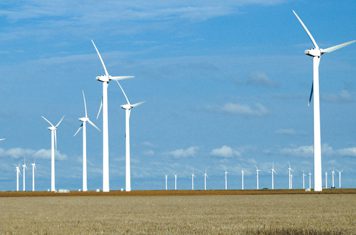West Central Texas is the heart of wind country in the United States. It is home to many of the nation’s largest wind farms—Roscoe, Sweetwater, Horse Hollow, and Buffalo Gap, among others.
It was out of that rich wind tradition that Abilene High Lift Aerial was founded in 2010 by a group of four Texas investors. Their sole intent was performing wind turbine blade inspections and repairs—initially within the wind-centric 100-mile radius of Abilene, Texas.
It all started with the purchase of an aerial lift truck. Actually, make that “THE” aerial lift truck, as far as North America is concerned. Figure 1
The Ruthmann Steiger TTS 1000 is unlike any other model aerial lift truck in the world. To date, the company has built two. The other is operated in South America aiding in the installation of wind turbines.
The aerial lift is a self-contained unit on a trailer assembly, which is towed by a custom-built, all-wheel-drive Mack semi truck. It was necessary to have an all-wheel-drive semi due to harsh terrain and challenging weather conditions. At full extension, the lift rises to 328 feet, and has a 131-foot horizontal reach. It can safely operate at wind speeds in excess of 35 miles-per-hour.
“It’s the largest, most stable aerial lift truck in North America,” said Kevin Kutnink, national operations manager for Abilene High Lift Aerial. “When we’re up 200 feet in a 20 mph wind, it sways approximately one inch.”
The stability and height capabilities of Abilene’s lift—along with factors such as in-basket electrical and high-pressure water sources—that make it ideally suited for wind turbine blade maintenance and repair. Those operations make up 90 percent of Abilene High Lift Aerial’s business, according to Kutnink, whose wind energy industry experience includes positions with Vestas and then Siemens as a blade service technician, and later as a project manager. Blade maintenance and repair services performed using the TTS 1000 are done by Abilene High Lift personnel, or contracted to various blade service companies.
It’s the increased stability at those 200-300-foot heights that lies at the core of Abilene High Lift’s operating philosophy. That philosophy is displayed prominently on the company’s website, and reads:
“The goal of Abilene High Lift Aerial Services is to offer a safer means of accessing high reach locations. We believe safer and faster methods will ultimately lower customer cost and down time on a regular basis.”
That commitment to safe operations at height is why Abilene High Lift is able to assure its clients of the safety of their personnel. Figure 2
“We have a perfect safety record. We’ve never had any kind of catastrophic failure.” Kutnink, said.
Upon setup, the trailer assembly remains connected to the semi truck. The entire trailer assembly lifts off of the ground, using the semi as a counterweight. The entire system is electric over hydraulically controlled. An engine on the semi provides electrical power to the trailer, and the lift itself has an on-board diesel engine that operates the hydraulics. All of the systems are controlled via an integrated computer system. Should there be a malfunction, a secondary 5HP motor can operate the hydraulics to return personnel safety to the ground. All operations for both engines are in the basket. During operation, a second crewmember remains on the ground as an additional safety precaution.
“We have a setup where there’s a pickup truck that pulls a support/office trailer that has a workshop in the back with a generator,” Kutnink said. “We hook a power cord to the truck and then it’s wired up to the basket. So we don’t have to hang extension cords. They can plug-in sanders or welders. We have 115 and 220 volt receptacles’ in the basket. For the cleaning of blades we have a water truck on the ground and 220 volt pressure washer in the basket. This allows for complete washing without touching the turbine in any way.”
With the push toward maximum turbine efficiency, towers are getting taller and taller all the time. Coupled with the increasing number of wind turbines that are coming off warranty, the demand for equipment like the Abilene High Lift Aerial truck, according to Kutnink, will only continue to rise.
“Everything’s getting bigger. Nothing’s getting shorter,” Kutnink said. “Towers of the past were 90 meters tall. Now they’re over 100 meters. With a conventional truck, the operating height is about 230 feet to 260 feet. We provide the extra reach needed when you have a tower that is 300-feet tall to begin with. We can reach to the top of the nacelle with no problem.”
The additional height and reach also allows Abilene High Lift Aerial to have a “hands-off” approach in performing maintenance services. Figure 3
“If we need to pressure wash, we don’t have to get out of the basket. We don’t have to touch the tower. We don’t have to touch the nacelle. We don’t have to put cables up. We don’t have to drill any holes,” Kutnink said. “When using an aerial platform, they have to put up all that rigging to go up and down the blade. Those are really susceptible to high wind conditions. If the wind goes up at all, they can’t do the work, where we still can safely.”
One of the more impressive benefits of the TTS 1000, according to Kutnink, is the cost savings that arise from having highly sought-after capabilities in a self-contained unit—specifically, he mentioned, when compared to using a crawler crane.
“Just to bring in the crane costs $65,000. We charge $5 per mile to get to a wind farm. If it’s anywhere within 100 miles of Abilene, Texas, we don’t charge anything. Our mobility costs are minimal compared to a crane,” Kutnink said.
Regarding agility, the TTS 1000 can move from one turbine site to another in much less time than a crane. “When they have to move a crane from one site to another, it can take days if they can’t crawl,” Kutnink said. “It takes us anywhere from five minutes to 35 minutes to move from tower to tower at the wind farm.” Figure 4
As a recent “real world” example, this past summer, Abilene High Lift Aerial was contracted for warranty work on 40 wind turbines. The company who hired Abilene had seven other projects of the same nature running concurrently throughout the U.S. Due to the agility and efficiency of the TTS 1000, Abilene High Lift was able to complete the work on all 40 turbines. In the same time frame, the most number of turbines completed by any of the other sites was 15. The average number of completions in the same time frame among the other six sites was eight turbines.
“It’s just so agile. It’s easy to move and easy to operate. We can drive it 70 miles per hour down the highway. It has six-wheel steering on the trailer too. The trailer wheels turn in the same direction as the front wheels,” Kutnink said. “Onsite we can drive the trailer separately from the truck to maneuver into very tight places. Then when in position, raise the whole truck and trailer and then rotate the semi into it’s locked position with the touch of a button.”
Response from customers who have chosen Abilene High Lift Aerial has been overwhelmingly positive, Kutnink said. These affirmations about the company’s lift truck and services most often surround the speed and efficiency of the equipment, as well as Abilene High Lift personnel’s ability to quickly, thoroughly train site staff on the important safety aspects of the lift truck.
In one recent review, a customer rated Abilene High Lift very highly, using words like “professional,” and “productive” and extremely “safe”. He went on to say that he was very “pleased with their workmanship.”
After word began to spread about the capabilities of Abilene High Lift Aerial’s truck, demand for its services has increased dramatically. Figure 5
“We had business come in from all over the United States,” Kutnink said. “From everywhere—from Montana to California to Iowa.”
As far as the future is concerned for Abilene High Lift Aerial, it’s looking quite bright.
“The schedule is very full for the next few months,” Kutnink said. “We’re only going to get busier and busier.”
There are more than 5,000 wind turbines currently operating in the West Texas area that have gone out-of-warranty within the past year, Kutnink said. Abilene expects that its services will continue to be in high demand, as those out-of-warranty turbines account for thousands of blades that now need leading edge or other repairs due to weather conditions and various other issues.
The company does plan to purchase several smaller lift trucks, mostly for leading edge repair. There are no present plans, Kutnink said, to acquire an additional TTS 1000, but would not rule out the possibility going forward. Side Bar
In addition to wind turbine blade maintenance, Abilene High Lift Aerial offers a variety of services to other industries and clients. This month, the truck will be headed to Memphis, Tennessee for several months to assist other contractors with interior structure work, plumbing, electrical, and HVAC at The Pyramid.
The company also does regular sanding and painting maintenance on the outside of the U.S. Army’s F-14 simulator in Maryland.
For more information about Abilene High Lift Aerial’s “largest, most stable aerial lift truck in North America,” visit www.abilenehighlift.com, or call 800-588-5012.

















